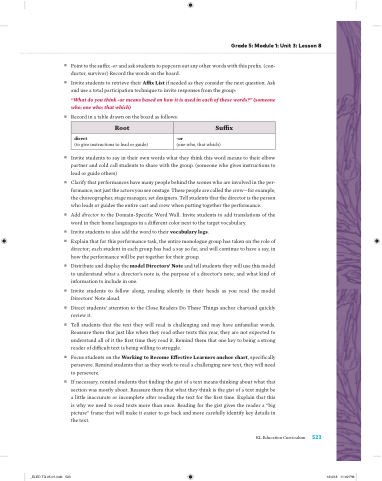Page 547 - EL Grade 5 Teacher Guide
P. 547
Grade 5: Module 1: Unit 3: Lesson 8
■ Point to the su x -or and ask students to popcorn out any other words with this pre x. (con- ductor, survivor) Record the words on the board.
■ Invite students to retrieve their A x List if needed as they consider the next question. Ask and use a total participation technique to invite responses from the group:
“What do you think -or means based on how it is used in each of these words?” (someone who; one who; that which)
■ Record in a table drawn on the board as follows:
■ Invite students to say in their own words what they think this word means to their elbow partner and cold call students to share with the group. (someone who gives instructions to lead or guide others)
■ Clarify that performances have many people behind the scenes who are involved in the per- formance, not just the actors you see onstage. These people are called the crew—for example, the choreographer, stage manager, set designers. Tell students that the director is the person who leads or guides the entire cast and crew when putting together the performance.
■ Add director to the Domain-Speci c Word Wall. Invite students to add translations of the word in their home languages in a di erent color next to the target vocabulary.
■ Invite students to also add the word to their vocabulary logs.
■ Explain that for this performance task, the entire monologue group has taken on the role of director; each student in each group has had a say so far, and will continue to have a say, in how the performance will be put together for their group.
■ Distribute and display the model Directors’ Note and tell students they will use this model to understand what a director’s note is, the purpose of a director’s note, and what kind of information to include in one.
■ Invite students to follow along, reading silently in their heads as you read the model Directors’ Note aloud.
■ Direct students’ attention to the Close Readers Do These Things anchor chartand quickly review it.
■ Tell students that the text they will read is challenging and may have unfamiliar words. Reassure them that just like when they read other texts this year, they are not expected to understand all of it the rst time they read it. Remind them that one key to being a strong reader of di cult text is being willing to struggle.
■ Focus students on the Working to Become E ective Learners anchor chart, speci cally persevere. Remind students that as they work to read a challenging new text, they will need to persevere.
■ If necessary, remind students that nding the gist of a text means thinking about what that section was mostly about. Reassure them that what they think is the gist of a text might be a little inaccurate or incomplete after reading the text for the rst time. Explain that this is why we need to read texts more than once. Reading for the gist gives the reader a “big picture” frame that will make it easier to go back and more carefully identify key details in the text.
EL Education Curriculum 523
Root
Su x
direct
(to give instructions to lead or guide)
-or
(one who, that which)
_ELED.TG.05.01.indb 523
12/4/18 11:49 PM


